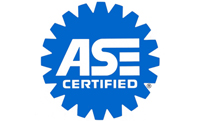What kind of
maintenance is recommended for the cooling system
|
Vol. Per Cent
Coolant |
Boiling Point
°F (at 0 psig) |
Freezing
Point °F |
|
10 |
215 |
+25 |
|
20 |
217 |
+16 |
|
30 |
219 |
+4 |
|
40 |
222 |
-12 |
|
50 |
226 |
-34 |
|
60 |
231 |
-62 |
|
70 |
238 |
-84 |
|
80 |
250 |
-57 |
|
90 |
272 |
-33 |
|
100 |
330 |
-9 |
Replacing coolant on a regular
basis will prolong the life of the radiator and other
cooling system components. Most new car maintenance
schedules call for coolant changes every three years or
50,000 miles. Many professional mechanics consider that too
long and recommend every two years or 24,000 miles.
There are some who argue that annual coolant changes on late
model vehicles with bimetal engines (aluminum heads/iron
blocks) and/or aluminum radiators is a good idea.
It does not really make much difference how often the
coolant is changed as long as it is changed before losing
its corrosion resistance. Antifreeze is made of ethylene
glycol (which never wears out) and various additives (which
do wear out).
Some additives provide "reserve alkalinity" to neutralize
internal corrosion before it can start. As long as the
coolant is changed before its reserve alkalinity is
depleted, the cooling system should be no worse for the
wear. If you wait too long, the result can be expensive
internal corrosion in the radiator, heater core and engine.
How can you tell when it is time to change the coolant? The
only way to know if the coolant still has adequate corrosion
protection is to test it. By dipping a test strip in the
coolant and noting its color change, you can determine
coolant condition and whether or not it is time to replace
it.
When coolant is changed, the system should be reverse
flushed rather than simply drained. This helps dislodge and
remove accumulated debris and debris in the system. It also
removes old coolant that would otherwise remain in the
engine block.
Use of a cooling system cleaner is not necessary unless the
system has been badly neglected and is full of lime
deposits.
The cooling system should be refilled with a 50/50 mixture
of ethylene glycol antifreeze and clean water. This provides
freezing protection down to -34 degrees F and boil-over
protection to 265 degrees F.
When coolant is changed, inspect belts and hoses. Make a
visual inspection for leaks. Pressure test radiator and cap.
Check operation of heater and defroster.
The thermostat does not need changing unless it has been
causing trouble or the engine has severely overheated. If a
thermostat is replaced, it should have the same temperature
rating as the original. This is extremely important on late
model vehicles with computerized engine controls. Fuel,
ignition and emission functions are all affected by coolant
temperature.
OneStop Auto Shop
Call Today for
all of your Auto Repairs
and Maintenance
in Hollywood, Ca.!
(323) 227-9999
|






















